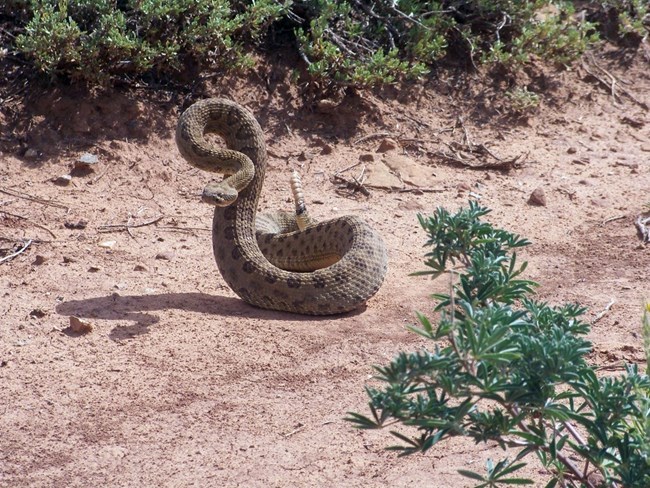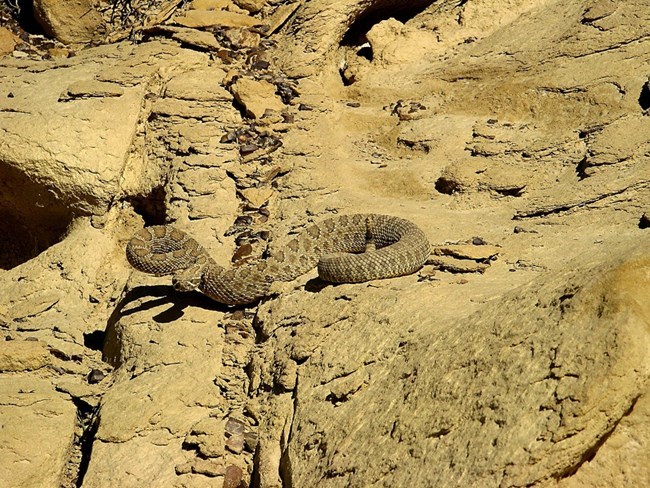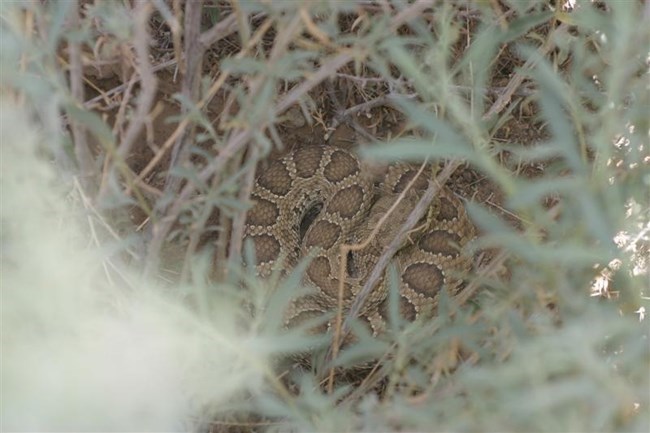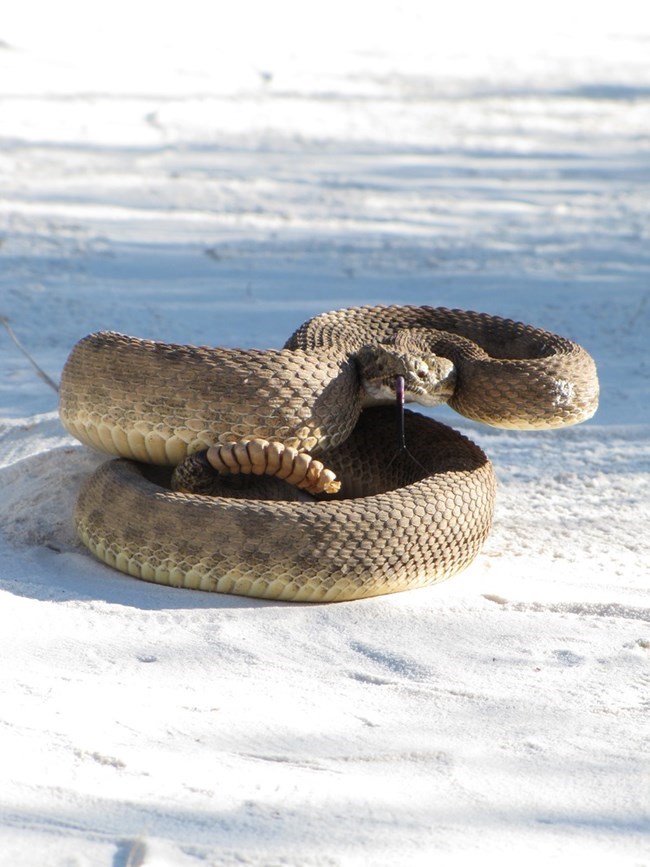Last updated: May 6, 2021
Article
Prairie Rattlesnakes

NPS Photo
The Prairie Rattlesnake
Prairie Rattlesnakes can grow up to 5 feet long. This species of rattlesnake has a triangular head and body covered in dark blotches which gradually turn into rings as they near the tail. Prairie Rattlesnakes are thermosensitive, meaning that they can detect heat very well. These snakes have a heat-sensitive pit on each side of their head between the nostril and the eye.
The Prairie Rattlesnake has the largest range of any rattlesnake species in the country. Their range extends through the Great Plains, stretching from Canada to Mexico. Although these snakes enjoy open grasslands and prairies, they may also seek out forested environments.

NPS Photo
Putting the “Rattle” in Rattlesnake
Rattlesnakes use their tails to make a rattling noise. This noise is intended to make predators aware of its presence. When a rattlesnake is trying to scare off a predator, it shakes the muscles at the base of its tail. This shaking vibrates the segments of the rattlesnake’s tail together to make a rattling sound -- there’s actually nothing inside of the segments to make the rattle. Instead, the rattle one hears is merely the sound of the segments shaking against each other.
The number of chambers in a snake’s rattle represent how many times it has shed its skin, which can be multiple times per year. Unlike human skin, which grows as we grow, snake skin doesn’t grow with the snake. If a snake is growing too big for its skin, then it must shed that skin in order to keep growing. Prairie rattlesnakes shed an average of twice per year, but because rattle chambers can break, the number of rattles on a snake’s tail do not indicate its age.
Some other snakes, such as Bull Snakes, mimic the sound of a rattlesnake to ward off predators. Although they don’t have the rattling appendage, they may slap their tails against hard ground surfaces and leaves to produce a rattle-like sound.

NPS Photo
To Eat or Be Eaten
Rattlesnakes eat all sorts of prey, including mice, small birds, gophers, prairies dogs, and any other small mammal they may find.
Rattlesnakes hunt these animals using a mixture of sight, smell, and heat sensing. The thermosensitive pits on their heads help rattlesnakes detect heat, allowing them to track their prey itself. Instead of their nostrils, rattlesnakes use their tongue to smell. By sticking their tongue in and out, rattlesnakes pick up microscopic particles that tell them what they’re smelling and whether or not it could make a tasty snack.
Rattlesnakes are ambush predators: they hunt prey until they are within striking distance. Once the rattlesnake draws close to its prey, the snake’s venomous fangs fold down (they fold up into the roof of the mouth when the snake is at rest). The snake strikes and injects venom in order to weaken its prey, waits for the animal to die, then eats it whole.
Although a rattlesnake’s day may involve eating, it may also involve getting eaten. Some animals in scotts bluff seek out rattlesnakes as prey. A number of predatory birds like the Red-tailed Hawk and Golden Eagle will snatch up a snake snack.

NPS Photo
Throughout the Seasons
Male rattlesnakes begin searching for female mates in the spring and early summer. Snakes are ready to mate at the age of three. Males compete in combat rituals to earn mating rights to nearby females. In these combat “dances,” males face each other with their heads and part of their bodies off the ground, then they intertwine and attempt to throw each other into the ground. The male which is not thrown into the ground earns dominance and mating rights.Female rattlesnakes give birth to 8-17 baby snakes in the late summer. Rattlesnakes are viviparous, which means that they give birth to live young instead of laying eggs. Young rattlesnakes tend to be brighter in color than adult rattlesnakes but have similar markings. Although mothers stay with their young for several days, young rattlesnakes are able to immediately take care of themselves -- they are born venomous.
In the winter, ground temperatures are too cool for snakes to be active. Snakes are coldblooded animals, meaning that they can’t internally regulate their body temperature. As a result, they must brumate. Brumation is a period of sluggishness and reduced activity that some reptiles utilize in colder environments. Unlike a hibernating creature, snakes don’t sleep during brumation, but simply become very lethargic. Snakes brumate in dens called hibernaculums, which can be inter-species. Snakes have no way to dig, so these hibernaculums are often underneath rocky outcrops or in underground holes. Occasionally, snakes will even take up winter residence in other animals’ homes such as abandoned prairie dog burrows.
Snakes typically come out of hibernaculums and return to their summer activity in April or May when the weather is warm enough. At this point, they return to active hunting and mating if they are sexually mature.

NPS Photo
Rattlesnake Bites
When a rattlesnake bites, its two venom-bearing teeth fold down from the roof of its mouth. Once its teeth are set in its prey, the rattlesnake releases venom through hollow cavities in its teeth. Rattlesnakes are venomous and can control the amount of venom they release while biting, often releasing 20-50% of their venom when hunting small prey.
To avoid rattlesnake bites, keep a keen eye and ear out while hiking. Prairie rattlesnakes often seek out spots where they are well-hidden and can be found under thick prairie grasses or in shaded badlands formations. One of the best ways to prevent a bite is to give these animals plenty of space and not try to handle them. Bites are more likely to happen if you provoke or attempt to catch a rattlesnake.
If you are bitten by a rattlesnake, please call 911 immediately.
